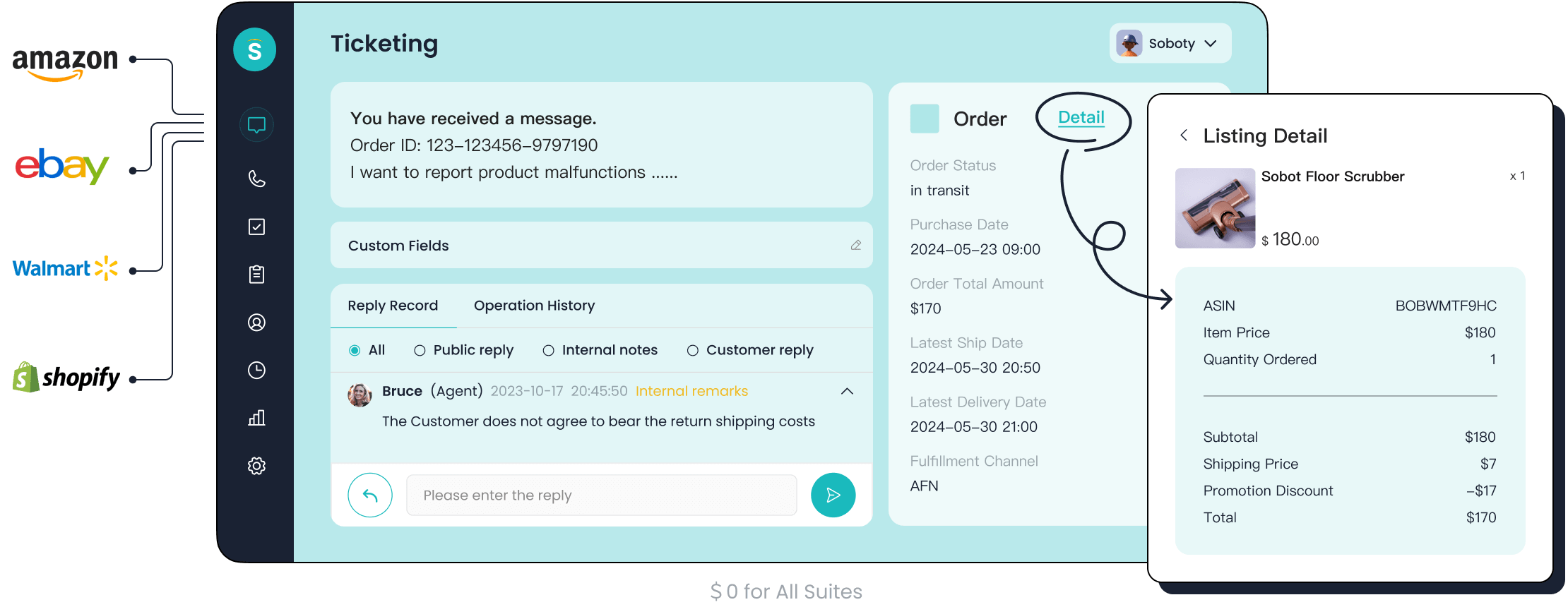Top Differences Between Client and Customer Explained

You may wonder what is the difference between client and customer when you work in a contact center. Imagine you handle a support ticket for a business that buys your service every month. That business is your client. Someone who buys a single product from your store is your customer. Knowing the difference helps you serve each person better. Sobot and Sobot AI give you tools to manage both clients and customers across all channels, making your work more efficient.
Definitions
Client
A client is someone who seeks professional services to solve specific needs or problems. You often see clients in fields like law, consulting, finance, or design. According to the Insights Association Code of Standards, a client can be any person, business, or department that requests or subscribes to a service or project. In professional services, clients usually sign formal agreements and expect ongoing support. The Forage article explains that you build strong relationships with clients by understanding their needs and offering tailored solutions. You may work with a client for months or even years, adjusting your services as their needs change. Many companies, such as those in finance or enterprise services, rely on clients to shape their business strategies. Sobot helps you manage these relationships by providing tools that track client interactions and automate support tasks, making it easier to deliver personalized service.
Customer
A customer is someone who buys a product or service, often in a single transaction. You see customers in retail stores, online shops, or restaurants. Customers usually do not need a long-term relationship with the business. They want a quick and easy buying experience. For example, when you buy a coffee from a café, you are a customer. Businesses focus on making the purchase process smooth and satisfying for customers. Sobot’s omnichannel solutions help you serve customers by unifying messages from different channels, such as chat, email, and phone. This makes it simple to answer questions and solve problems fast. Companies in retail, e-commerce, and entertainment use Sobot to improve customer satisfaction and keep customers coming back. By understanding the difference between customers and clients, you can choose the right approach for each group and improve your service quality.
What Is the Difference Between Client and Customer

Relationship Type
When you ask what is the difference between client and customer, you start by looking at the type of relationship each one has with your business. Clients usually want a long-term partnership. They expect you to understand their needs and offer ongoing support. For example, a company that hires you to manage their IT services for a year is your client. You build trust with them over time.
Customers, on the other hand, often want a quick and simple transaction. They buy a product or service and may not return. Think about someone who buys a pair of shoes from your online store. That person is your customer. The relationship is short and focused on the purchase.
You can see the main differences in the table below:
| Factor | Relationship Selling | Transactional Selling |
|---|---|---|
| Customer Engagement | Continuous communication, personalized approach | Interaction limited to the point of sale |
| Customer Retention | Builds trust and long-term loyalty | Focuses on quick sales, low retention |
| Sales Cycle | Longer, involves nurturing and ongoing support | Shorter, aims for fast closure |
| Lifetime Value | Higher due to repeat business and referrals | Limited, often one-time purchases |
| Customer Experience | Emphasizes understanding and solving customer problems | Focuses on product features and price |

Sobot’s Ticketing System helps you manage both types of relationships. You can track ongoing support requests for clients and handle quick questions from customers. The system lets you automate responses for simple transactions and personalize support for long-term clients. This flexibility means you can serve both groups well, no matter the relationship type.
Tip: Building strong client relationships can lead to more referrals and higher lifetime value, while efficient customer service can boost satisfaction and repeat purchases.
Engagement Duration
Another way to answer what is the difference between client and customer is to look at how long each relationship lasts. Clients usually work with you for a long time. For example, an architect may help a client design and build a house over several months or even years. This kind of relationship needs trust and regular communication.
Customers, in contrast, often interact with your business for a short time. When someone buys a coffee from your café, the engagement is quick. They may not come back, and you may not remember them. These short-term interactions focus on speed and convenience.
CRM systems, like the one in Sobot’s Ticketing System, help you manage both long and short engagements. For clients, you can keep detailed records and follow up regularly. For customers, you can resolve issues quickly and move on to the next transaction. This approach helps you deliver the right level of service for each group.
Note: Long-term client relationships often require more effort but can bring greater rewards. Short-term customer interactions are easier to manage but may not lead to lasting loyalty.
When you understand what is the difference between client and customer, you can choose the best way to manage each relationship. Sobot’s solutions give you the tools to support both, making your business more efficient and your service more effective.
Client vs Customer in Customer Service
Service Expectations
You will notice that service expectations differ when you compare client vs. customer in a contact center. Clients often expect a personalized, ongoing relationship. They want you to understand their needs and provide tailored solutions over time. For example, a business client may expect regular updates, proactive advice, and a dedicated support agent. Customers, on the other hand, usually look for quick answers and fast solutions. They want a smooth transaction and immediate help if something goes wrong.
Recent studies show that 88% of service interactions now involve multiple channels, such as chat, phone, or email. Younger generations, like Gen Z and millennials, value self-service options. In fact, 38% will leave if they cannot solve issues themselves, and 52% will not buy from companies without self-service. Seamless channel switching boosts satisfaction for 93% of people. These numbers show that both clients and customers want convenience, but clients expect more depth and continuity in their service.
Sobot’s omnichannel platform helps you meet these expectations. You can offer self-service for quick customer queries and provide ongoing, personalized support for clients. This flexibility improves satisfaction and builds loyalty.
Support Approaches
Support approaches also differ in the client vs. customer debate. Clients need ongoing support, regular check-ins, and detailed records of past interactions. You may need to track project milestones, manage service agreements, and provide proactive updates. Customers usually need fast, efficient help with one-time issues, such as returns or product questions.
A table below shows how organizations use different support approaches:
| Organization | Support Approach Description | Key Outcomes / Metrics |
|---|---|---|
| AAA Northeast | Used analytics to categorize calls and train agents for specific needs. | Reduced call handling time by 14 seconds overall. |
| Delta Dental of Minnesota | Applied analytics to improve first call resolution and process improvements. | Achieved 20% better first call resolution. |
| GreenPath Financial Wellness | Used analytics to target campaigns and identify client needs. | Increased VIP clients served by 152%. |
Sobot’s Ticketing System lets you automate ticket routing, manage SLAs, and keep all communication in one place. You can handle both ongoing client projects and quick customer requests without losing context. This approach leads to higher retention and satisfaction for both groups.
Tip: Using an omnichannel solution like Sobot ensures you never lose track of a conversation, no matter how your clients or customers reach out.
Business Implications
Communication Strategies
Understanding the difference between customers and clients shapes how you communicate in business. You need to tailor your messages to fit each group. For clients, you should focus on building trust and sharing insights that help them make decisions. Research shows that using charts and infographics makes complex data easy to understand. This helps clients see trends and choose the best path for their business. You can also use scenario analysis to show clients how your service impacts their goals.
For customers, clear and simple communication works best. Many companies use both print and digital channels to reach customers. A survey found that 83% of businesses include calls to action in printed mail, which increases digital response rates by almost 9% (source). Omnichannel strategies, like those offered by Sobot, let you connect with customers on their favorite platforms—email, chat, phone, or social media. Sobot’s unified workspace helps you keep messages consistent and personal, no matter the channel.
Tip: Personalizing your communication and using the right channel for each group increases engagement and satisfaction.
Retention and Loyalty
Retention and loyalty programs work differently for customers and clients. You need to track key metrics like Customer Lifetime Value (CLV), churn rate, and repeat purchase rate. Data shows that existing customers are 60-70% more likely to buy again, while new prospects only convert 5-20% of the time (source). Loyal customers spend 67% more over time.
You can use data analytics to personalize offers and rewards. For example, Starbucks uses its app to send custom deals, which keeps customers coming back. Sobot’s Ticketing System and omnichannel solutions help you collect and analyze customer data. This lets you create targeted campaigns and loyalty programs for both customers and clients. By understanding what each group values, you can improve satisfaction and grow your business.
| Metric | Description | Impact |
|---|---|---|
| Customer Lifetime Value (CLV) | Measures total value over time | Higher for loyal clients |
| Churn Rate | Tracks how many leave | Lower with strong retention |
| Repeat Purchase Rate | Shows how often people return | Increases with loyalty |
Client vs. Customer: Comparison Table

Key Differences
You often hear the terms client and customer, but knowing the difference between customer and client helps you choose the right approach in business. The table below shows the main points of client vs. customer in a way that is easy to scan and understand:
| Attribute | Client | Customer |
|---|---|---|
| Relationship Type | Ongoing, partnership | Transactional, one-time |
| Engagement Duration | Long-term | Short-term |
| Service/Product Focus | Services, advice, or solutions | Products or quick services |
| Personalization Level | High, tailored to needs | Standardized, less personalized |
| Support Expectations | Regular updates, proactive communication | Fast, efficient responses |
| Example Industry | Finance, consulting, enterprise services | Retail, e-commerce, restaurants |
Tip: When you use a CRM or omnichannel platform like Sobot, you can track both types of relationships and adjust your support style for each group.
Real-World Scenarios
You see the impact of client vs. customer in many industries. Here are some examples:
- In retail, a person who buys a pair of shoes from your online store is a customer. You want to give them quick answers and a smooth checkout. Sobot’s omnichannel solution helps you respond fast, whether they reach out by chat, email, or phone.
- In finance, a business that hires your team for ongoing investment advice is a client. You build a long-term relationship, offer regular updates, and keep detailed records. Sobot’s Ticketing System lets you manage these ongoing requests and keep all communication in one place.
- Companies like Nike use social media to give customers immediate help, building loyalty through fast, personal responses (source).
- Banks such as the Commercial Bank of Kuwait use live chat to support clients, offering tailored advice and quick solutions. This approach improves satisfaction and trust.
- Travel platforms like Hipmunk use AI chatbots to handle customer bookings and questions, showing how you can serve customers efficiently with automation.
You can use Sobot’s unified workspace to get a 360-degree view of every interaction. This helps you understand the difference between client and customer, so you can deliver the right experience every time.
Choosing the Right Term
Industry Standards
You may wonder when to use "client" or "customer" in your business communication. Industry guidelines help you make the right choice. According to UserGuiding, you should use "customer" for people who make one-time or short-term purchases. These buyers focus on immediate value, such as someone buying a coffee or a pair of shoes. You use "client" for those who want a long-term, trust-based relationship. Clients often need ongoing services, like a business that hires you for consulting or IT support. This distinction is common in many industries and helps you set the right expectations.
Legal documents often use "customer" as the formal term for anyone using your services under a contract. For example, the Evidence Terms of Service defines "customer" as the party accessing or using the service. Some agreements mention "customer client" to describe a layered relationship, but most business settings rely on context. You should remember that "customer" is the preferred term in contracts, while "client" signals a deeper, ongoing partnership in daily business language.
Tip: When you use Sobot’s omnichannel solutions, you can easily track both client and customer interactions, making it simple to apply the right term in every situation.
Practical Tips
You can follow a few simple tips to choose the best term for your business needs:
- Think about the relationship. Use "client" if you offer ongoing services or advice. Use "customer" for single transactions or product sales.
- Match your language to your audience. Some people prefer stories or examples, while others want numbers or facts. Adjust your terms to fit their style.
- Support your choice with evidence. Use recent data, expert opinions, or real examples to show why you picked "client" or "customer."
- Stay flexible. Listen to feedback and change your approach if needed. Your audience may respond better to one term over the other.
- Use Sobot’s Ticketing System to keep records of both client and customer interactions. This helps you personalize your communication and improve service quality.
When you understand the difference between client and customer, you can build stronger relationships and deliver better support. Sobot’s solutions help you manage both groups, so you always use the right term and approach for every interaction. For more on industry standards, see UserGuiding’s article.
You now understand what is the difference between client and customer. When you use the right term, you improve communication and deliver better service. Businesses that make this distinction see up to 62% higher retention rates and 40% higher conversion rates. Case studies show that clear segmentation leads to more effective marketing and stronger trust. Sobot’s omnichannel solutions help you manage both clients and customers, so you can boost satisfaction and drive growth.
FAQ
What is the main difference between client and customer?
The main difference between client and customer is the relationship. Clients usually want ongoing services and support. Customers often make one-time purchases. For example, a business using Sobot’s Ticketing System is a client. Someone buying a coffee is a customer.
Why does the difference between client and customer matter in customer service?
You need to know the difference between client and customer to give the right support. Clients expect long-term help and personal attention. Customers want fast answers. Sobot’s omnichannel solutions help you manage both types of relationships for better service.
Can one person be both a client and a customer?
Yes! Sometimes, one person can be both. For example, a company may buy your product (customer) and also hire you for ongoing support (client). Sobot’s unified workspace lets you track every interaction, so you always know how to help.
How does Sobot help manage the difference between client and customer?
Sobot’s Ticketing System and omnichannel platform let you handle both clients and customers. You can automate quick responses for customers and keep detailed records for clients. This helps you deliver the right service every time.
Where do you see the difference between client and customer in real life?
You see the difference between client and customer in many places. In retail, shoppers are customers. In finance, businesses needing advice are clients. Sobot serves both groups across industries like retail, finance, and e-commerce. Learn more at Sobot’s website.
Tip: Always match your support style to the type of relationship. This builds trust and keeps people coming back.
See Also
Best Voice of Customer Platforms Reviewed and Compared
Effective Strategies To Improve Live Chat Customer Experience
Key Features To Look For In CRM Call Center Tools